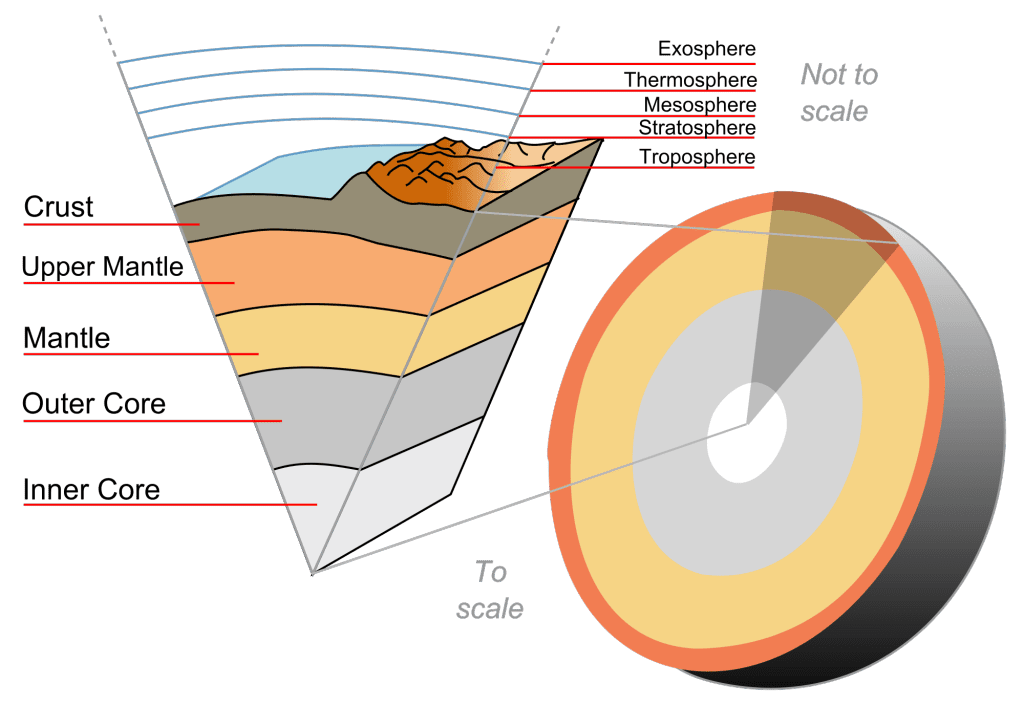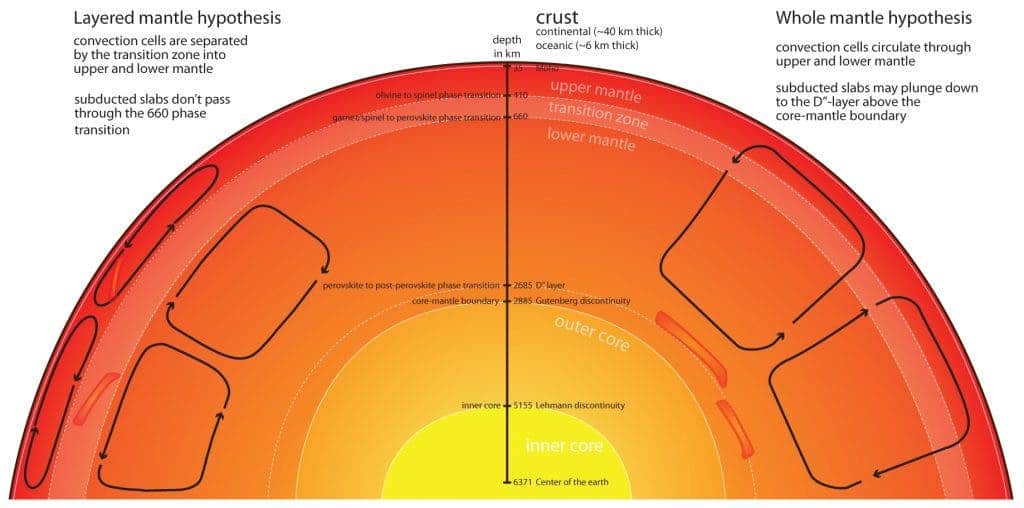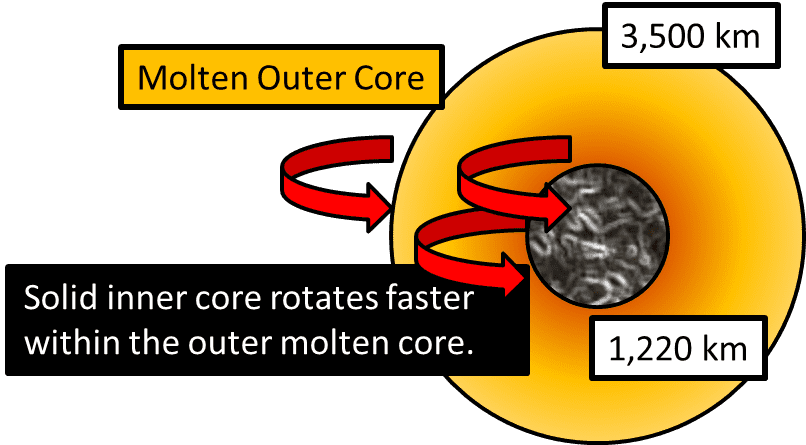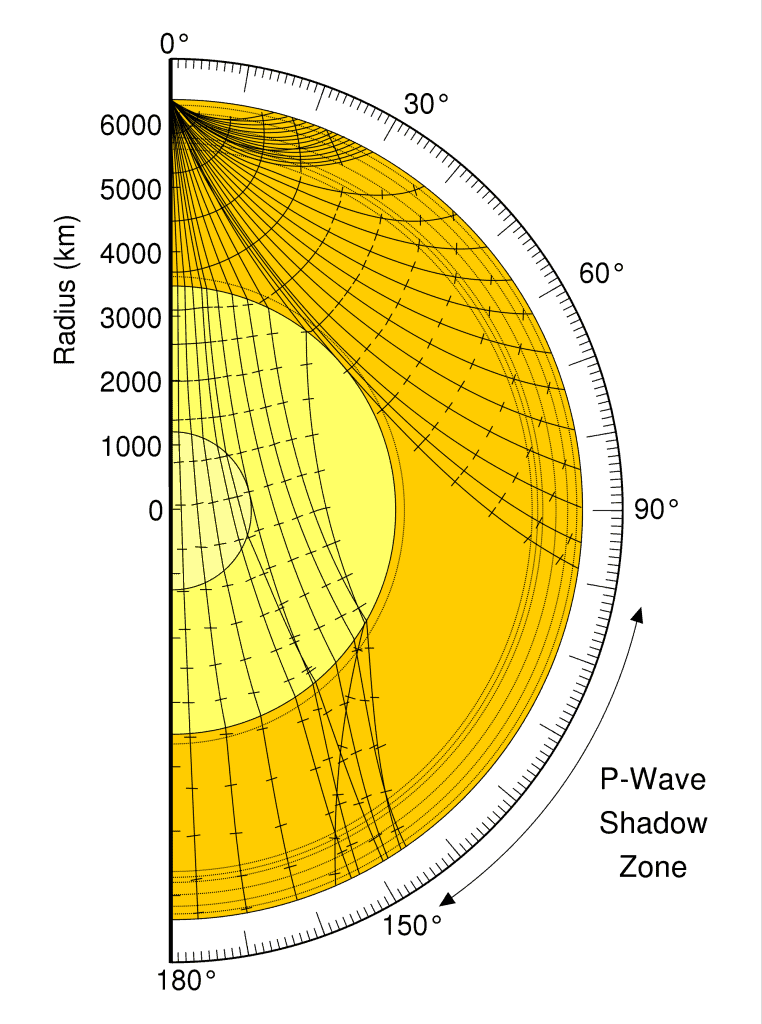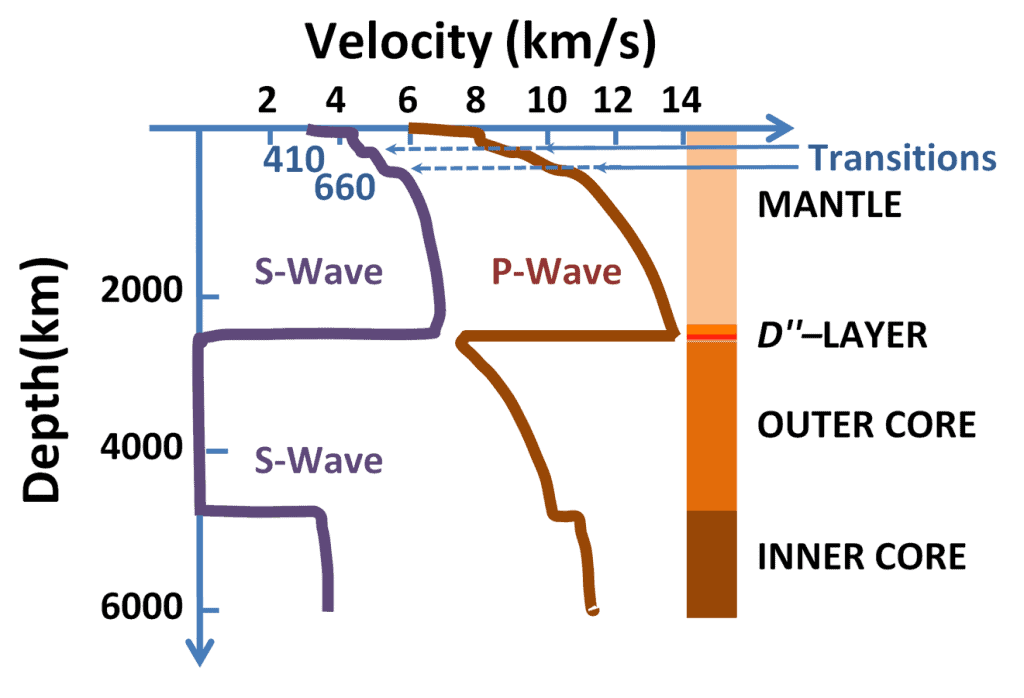Broadly speaking, the Earth has four layers: the solid crust on the outside, the mantle, and the core. The crust is the thinnest, the mantle is the thickest. But how do we know of all these geological layers without actually seeing them?
Before we look into each individual layer in more detail, here is some very basic information about the characteristics of Earth’s layers. The outer core is the only ‘liquid’ layer. Although the mantle also flows, it’s considered solid. More on that later. Also, the mantle is commonly split into three different sublayers, and the core is often split into two — the inner core and the outer core.
| Layer | Depth (from surface) | Primary composition | Key Characteristics |
|---|---|---|---|
| Crust | 0-35 km (oceanic), | Basalt (oceanic), | Thinnest layer; where all life exists |
| 0-70 km (continental) | Granite (continental) | ||
| Upper Mantle | 35-410 km | Peridotite | Part of the lithosphere and asthenosphere |
| Transition Zone (Mantle) | 410-660 km | Olivine, Spinel | Intermediate composition |
| Lower Mantle | 660-2900 km | Bridgmanite | High pressure and temperature |
| Outer Core | 2900-5180 km | Iron, Nickel (liquid) | Creates Earth’s magnetic field |
| Inner Core | 5180-6370 km | Iron, Nickel (solid) | Extreme pressure and temperature |
The crust — the surface layer
The crust is everything we can see and study directly. The thinnest layer of the Earth, the crust still measures about 40 km on average, ranging from 5–70 km (~3–44 miles) in depth. But at the scale of the planet, that’s less than the skin of an apple.
There are two main types of crust: continental and oceanic crust. The oceanic crust can be found at the bottom of the oceans or below the continental crust; it is generally harder and deeper, consisting of denser rocks like basalt, while the continental crust contains granite-type rocks and sediments. The continental crust is thicker on land.
The crust is also the only layer of the Earth that we’ve directly explored (researchers are trying to scrape the top mantle too, but these are new efforts). The deepest hole we’ve dug is just over 12 kilometers deep, so the only information we have about the deeper layers of the Earth comes indirectly, from geophysical and seismological research (which we’ll get to in a moment).
The crust is not one rigid, company layer — it’s split into several tectonic plates.
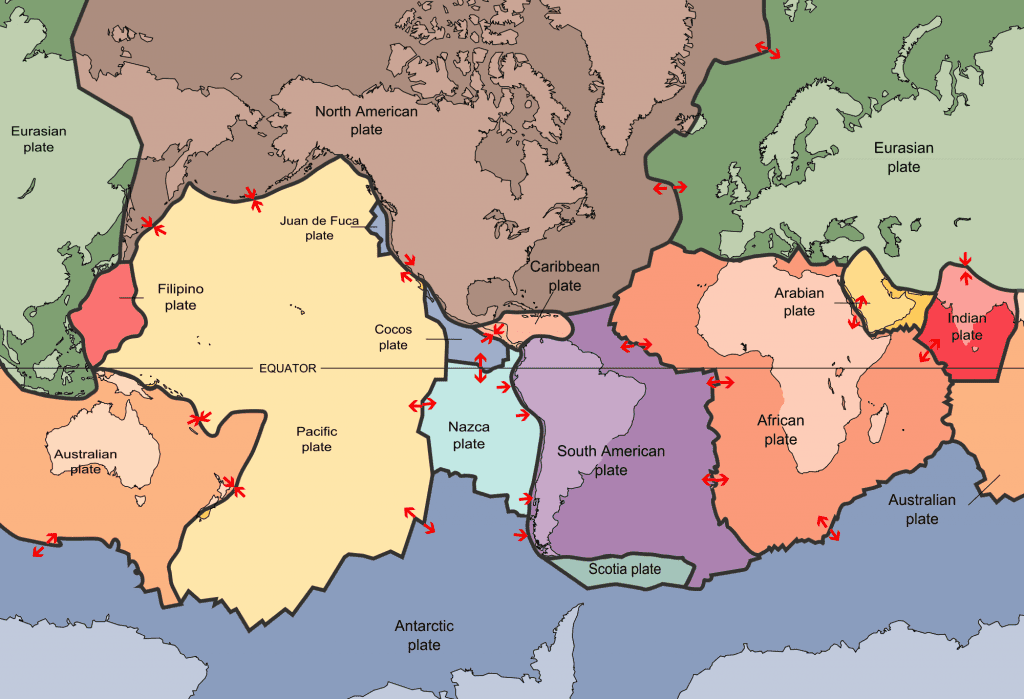
These tectonic plates are not stationary but are in relative motion one from another. Depending on the relationship and geologic setting, there are three types of tectonic plate boundaries:
- convergent (moving one toward the other);
- divergent (moving away from the other);
- and transformant (moving laterally).
Tectonic plates move around due to the heat energy generated by radioactive decay in the Earth’s core. This heat causes rises to the mantle layer, heats it up to move in a convection cycle. Sometimes, new crust material is created; other times, new crust material is destroyed
These plates “float” on the soft, plastic upper mantle. In fact, most of the magic in plate tectonics (and which affects all life on Earth) happens in the mantle.
The mantle — the thickest layer
The mantle extends down 2,890 km, making it the thickest layer of Earth. It makes up about 84% of Earth’s volume. Everything we know about the mantle we know indirectly, as no human study managed to go beyond the crust. Most of the things we know about the mantle we know from seismologic studies (more on that later).
The mantle is also divided into several layers. However, although there are geological and chemical differences between the layers of the mantle, the divisions within the mantle are primarily based on changes in seismic wave velocities rather than composition. However, these changes in seismic velocities are also related to different temperatures, pressures, and mineral structures.
| Sub-Layer | Depth (from surface) | Thickness | Key Characteristics |
|---|---|---|---|
| Upper Mantle | 35-410 km | 375 km | The upper part of it along with the crust forms the lithosphere. Characterized by relatively low pressure and temperature. Composed of peridotite. It has a solid but plastic consistency which means it flows very slowly. |
| Transition Zone | 410-670 km | 250 km | Zone where certain minerals change phase, resulting in a change in the speed of seismic waves. Olivine changes to wadsleyite and ringwoodite due to increasing pressures. |
| Lower Mantle | 670-2890 km | 2240 km | Characterized by high pressure and temperatures. Despite these conditions, it’s primarily solid. The dominant mineral in this layer is bridgmanite. |
The upper mantle extends from where the crust ends to about 670 km. Even though this area is technically viscous, it essentially consists of a rock — a rock called peridotite. Below that, the lower mantle extends from 670 to almost 2900 kilometers below the surface.
0ut of all the layers of the Earth, the mantle is probably the most intriguing for geologists. It’s basically accepted by now that the mantle is not in a steady state, but rather in a state of constant motion. There is a general convective circulation, with hot material upwelling towards the surface and cooler material going deeper.
It is generally thought that this convection actually directs the circulation of plate tectonics in the crust. Researchers are still debating the exact mechanisms through which this happens. However, the fact that the mantle is moving is undeniable.

Most earthquakes are formed on the surface, in the crust; as the plates ebb and flow tension builds up, and when that tension releases or when something breaks you have an earthquake. However, earthquakes can also happen in the mantle, and at those pressures, you can’t possibly talk about faulting and breaking. In subduction areas, where one plane goes beneath another, earthquakes have been observed at depths of up to 670 km.
The mechanism around these earthquakes is still not well understood, but one of the theories is that some minerals shift from one state to another, changing their volume in the process. This change in volume can lead to earthquakes.
However, we are getting closer and closer to understanding the mantle – even without getting there. In recent times, researchers have gone close to replicating the high temperature/pressure in the mantle, and high-level computer models are also revealing some of its secrets.
The core — deepest layer
We sometimes refer to the core as one thing, although the inner core and the outer core are fundamentally different – not layers of the same thing. The “solid” inner core has a radius of ~1,220 km, while the “liquid” outer core extends up to a radius of ~3,400 km.
Wait, if we couldn’t go to the mantle, how could we possibly know one is solid and one isn’t? Well, as before, the answer is the same: seismic waves (we’re almost there).
The inner core
The temperatures and pressures of the inner core are absolutely extreme, at approximately 5,400 °C (9,800 °F) and 330 to 360 gigapascals (3,300,000 to 3,600,000 atm).
It’s generally believed that the inner core is growing very slowly – as the core cools down, more of the outer core solidifies and becomes a part of the inner core. The cooling rate is very low though, at about 100 degrees Celsius per billion years. However, even this slow growth is thought to have a significant impact on the generation of Earth’s magnetic field by dynamo action in the liquid outer core.
Rather interestingly, the inner core seems to be asymmetric on the East-West line. There is a model that explains this asymmetry with melting on one side and crystallization on the other. This anomaly also likely affects the Earth’s magnetic field, creating an asymmetry on the crystallizing side.
The outer core
The outer core is a low viscosity fluid (about ten times the viscosity of liquid metals at the surface) – “liquid” is a rather improper term. As this layer has a very low viscosity, it is pretty malleable. It is the site of violent convection. It is also thought to suffer very violent convection currents – hey, and guess what? The churning of the outer core and its relative movement is responsible for the Earth’s magnetic field.
The hottest part of the outer core is actually hotter than the inner core; temperatures can reach 6,000° Celsius (10,800° Fahrenheit)—as hot as the surface of the sun.
How do we know that Earth’s layers even exist?
We can only see very small fractions of the Earth’s crust, which itself is a small fraction of our planet – so how can we know all these things?
Well, the best source of information we have is seismic waves. When an earthquake takes place, it releases pressure waves which then propagate throughout the entire planet. These waves carry with them information from the layers they pass through – including the mantle and the core.
By studying the propagation of waves through the Earth we can learn about the physical properties of the Earths interior. For example, some waves propagate only through solid mediums, while others propagate through both solid and liquid mediums – so they can show if some layer is solid or not. Seismic waves sample narrow swaths of the Earth’s interior so we can also isolate the information they carry; by analyzing several earthquakes recorded at several seismic stations, we can produce a CAT scan-like analysis of an area.
Rays bend and reflect based on the properties of the environment it passes through, and the speed of the wave is also affected by the environment.
Plenty more to learn
It’s not just seismology. Modern simulations in the lab showed how minerals likely behave at those temperatures and pressures, and we also have indirect gravitational and magnetic information, as well as studies on magma and crystals found on the surface – but the bulk of the information comes from global seismology.
It’s simply amazing that without even going close to it, we can know so much about the layers of the Earth.
While the majority of our planet remains inaccessible to direct human exploration, our understanding of its layers — from the crust to the core — is constantly evolving and refining.
This intricate knowledge of Earth’s structure has implications far beyond geology. It informs our understanding of natural disasters, aids in the search for natural resources, and even plays a critical role in studying climate change.
It’s also a shining example of human curiosity and ingenuity that can help us better understand not just the world beneath our feet, but the exoplanets as well.
